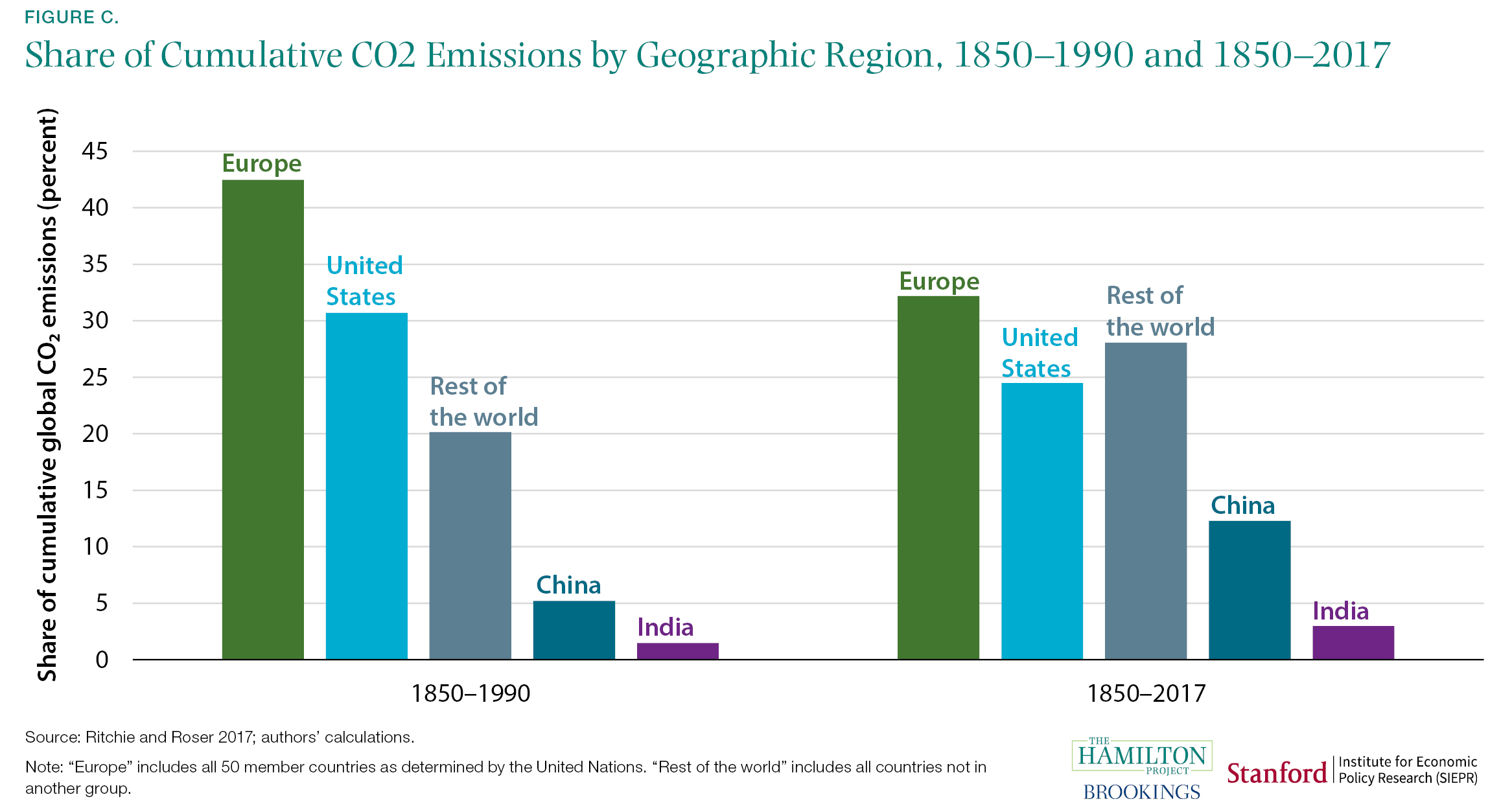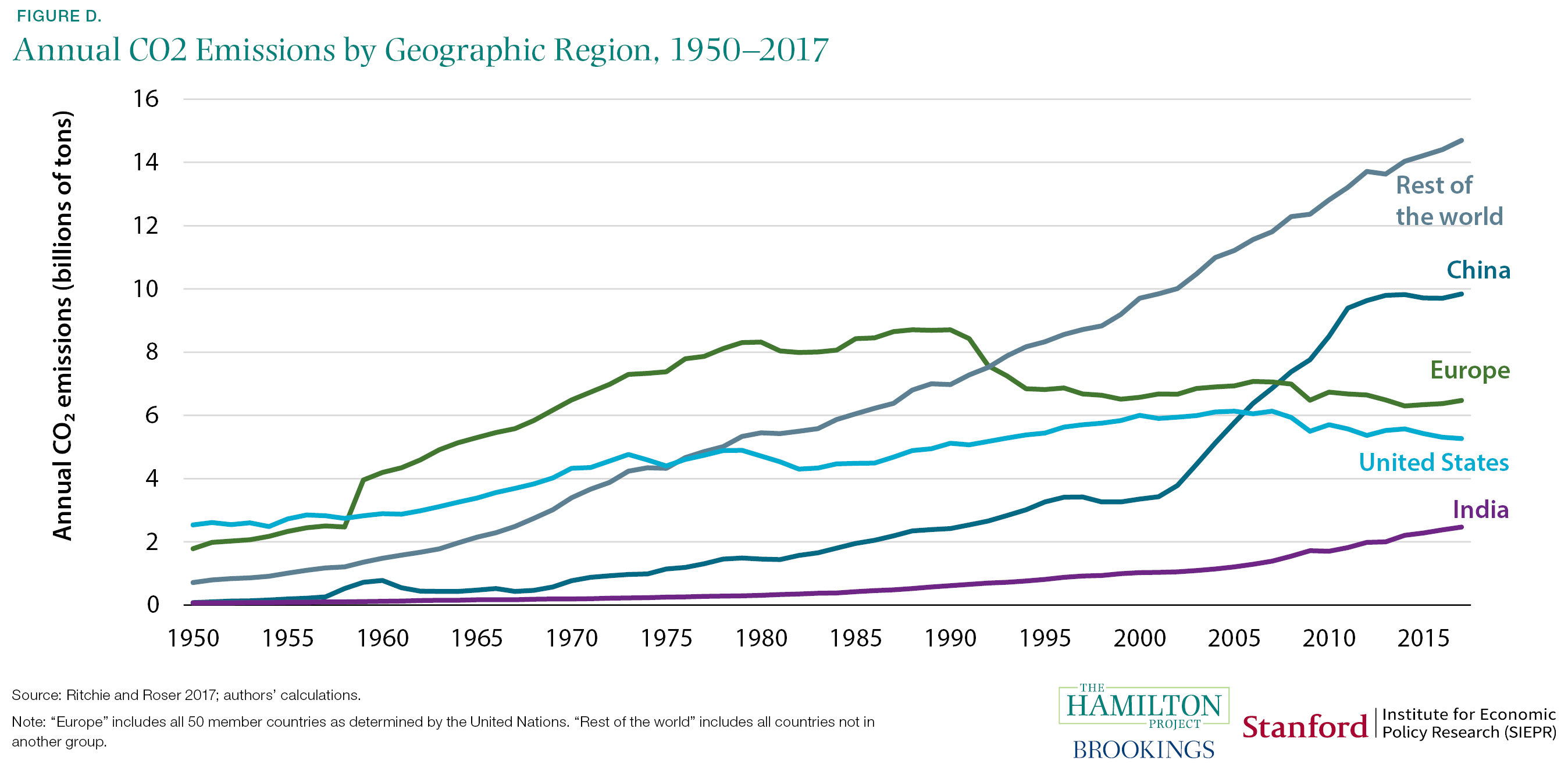The world’s climate has already changed measurably in response to accumulating greenhouse gas (GHG) emissions. These changes as well as projected future disruptions have prompted intense research into the nature of the problem and potential policy solutions. This document aims to summarize much of what is known about both, adopting an economic lens focused on how ambitious climate objectives can be achieved at the lowest possible cost.
Considerable uncertainties surround both the extent of future climate change and the extent of the biophysical impacts of such change. Notwithstanding the uncertainties, climate scientists have reached a strong consensus that in the absence of measures to reduce GHG emissions significantly, the changes in climate will be substantial, with long-lasting effects on many of Earth’s physical and biological systems. The central or median estimates of these impacts are significant. Moreover, there are significant risks associated with low probability but potentially catastrophic outcomes. Although a focus on median outcomes alone warrants efforts to reduce emissions of GHGs, economists argue that the uncertainties and associated risks justify more aggressive policy action than otherwise would be warranted (Weitzman 2009; 2012).
The scientific consensus is expressed through summary documents offered every several years by the United Nations–sponsored Intergovernmental Panel on Climate Change (IPCC). These documents indicate the projected outcomes under alternative representative concentration pathways (RCPs) for GHGs (IPCC 2014). Each of these RCPs represents different GHG trajectories over the next century, with higher numbers corresponding to more emissions (see box 1 for more on RCPs).
BOX 1. REPRESENTATIVE CONCENTRATION PATHWAYS (RCPS)
The expected path of GHG emissions is crucial to accurately forecasting the physical, biological, economic, and social effects of climate change. RCPs are scenarios, chosen by the IPCC, that represent scientific consensus on potential pathways for GHG emissions and concentrations, emissions of air pollutants, and land use through 2100. In their most-recent assessment, the IPCC selected four RCPs as the basis for its projections and analysis. We describe the RCPs and some of their assumptions below:
RCP 2.6: emissions peak in 2020 and then decline through 2100.
RCP 4.5: emissions peak between 2040 and 2050 and then decline through 2100.
RCP 6.0: emissions continue to rise until 2080 and then decline through 2100.
RCP 8.5: emissions rise continually through 2100.
The IPCC does not assign probabilities to these different emissions pathways. What is clear is that the pathways would require different changes in technology and policy. RCPs 2.6 and 4.5 would very likely require significant advances in technology and changes in policy in order to be realized. It seems highly unlikely that global emissions will follow the pathway outlined in RCP 2.6 in particular; annual emissions would have to start declining in 2020. By contrast, RCPs 6.0 and 8.5 represent scenarios in which future emissions follow past trends with minimal to no change in policy and/or technology.

The four RCPs imply different effects on global temperatures. Figure A indicates the projected increases in temperature associated with each RCP scenario (relative to preindustrial levels).[1] The figure suggests that only the significant reductions in emissions underlying RCPs 2.6 and 4.5 can stabilize average global temperature increases at or around 2°C. Many scientists have suggested that it is critical to avoid increases in temperature beyond 2°C or even 1.5°C—larger temperature increases would produce extreme biophysical impacts and associated human welfare costs. It is worth noting that economic assessments of the costs and benefits from policies to reduce CO2 emissions do not necessarily recommend policies that would constrain temperature increases to 1.5°C or 2°C. Some economic analyses suggest that these temperature targets would be too stringent in the sense that they would involve economic sacrifices in excess of the value of the climate-related benefits (Nordhaus 2007, 2017). Other analyses tend to support these targets (Stern 2006). In scenarios with little or no policy action (RCPs 6.0 and 8.5), average global surface temperature could rise 2.9 to 4.3°C above preindustrial levels by the end of this century. One consequence of the temperature increase in these scenarios is that sea level would rise by between 0.5 and 0.8 meters (figure B).

Countries’ Relative Contributions to CO2 Emissions Are Changing
The extent of climate change is a function of the atmospheric stock of CO2 and other greenhouse gases, and the stock at any given point in time reflects cumulative emissions up to that point. Thus, the contribution a given country or region makes to global climate change can be measured in terms of its cumulative emissions.
Up to 1990, the historical responsibility for climate change was primarily attributable to the more-industrialized countries. Between 1850 and 1990, the United States and Europe alone produced nearly 75 percent of cumulative CO2 emissions (see figure C). Such historic responsibility has been a primary issue in debates about how much of the burden of reducing current and future emissions should fall on the shoulders of developed versus developing countries.

Although the United States and other developed nations continue to be responsible for a large share of the current excess concentration of CO2, relative contributions and responsibilities are changing. As of 2017, the United States and Europe accounted for just over 50 percent of cumulative CO2 emitted into the atmosphere since 1850. A reason for this sharp decline (as indicated in figures C and D) is that CO2 emissions from China, India, and other developing countries have grown faster than emissions from the developed countries (though amongst major economies, the United States has one of the highest rates of per capita emissions in the world and is far ahead of China and India [Joint Research Centre 2018]). Therefore, it seems likely that in order to avert the worst effects of climate change, emissions reduction efforts will be required by both historic contributors—the United States and Europe—as well as more recently developing countries such as China and India.

Nations’ Pledges under the Paris Agreement Imply Significant Reductions in Emissions, but Not Enough to Avoid a 2°C Warming
The future of climate change might seem dismal in light of the recent increase in global emissions as well as the potential future growth in emissions, temperatures, and sea levels under RCPs 6.0 and 8.5. Failure to take any climate policy action would lead to annual emissions growth rates far above those that would prevent temperature increases beyond the focal points of 1.5°C and 2°C (figure E). As indicated earlier, cost-benefit analyses in various economic models lead to differing conclusions as to whether it is optimal to constrain temperature increases to 1.5°C or 2°C (Nordhaus 2007, 2016; Stern 2006).[2] Fortunately, countries have been taking steps to combat climate change, referred to in figure E as “Current policy” (which includes policy commitments made prior to the 2015 Paris Agreement). Comparing “No climate policies” and “Current policy” shows that the emissions reduction implied by current policies will lead to roughly 1°C lower global temperature by the end of the century. A large share of this lowered emission path is attributable to actions by states, provinces, and municipalities throughout the world.

Further reductions are implied by the 2015 Paris Agreement, under which 195 countries pledged to take additional steps. The Paris Agreement’s pledges, if met, would keep global temperatures 0.5°C lower than “Current policy” and about 1.5°C lower than “No climate policy” in 2100 (see figure E). Although this can be viewed as a positive outcome, a morenegative perspective is that these policies would still allow temperatures in 2100 to be 2.6 to 3.2°C above preindustrial levels—significantly above the 1.5 or 2.0°C targets that have become focal points in policy discussions.
In the following set of facts, we describe the costs of climate change to the United States and to the world as well as potential policy solutions and their respective costs.
No comments:
Post a Comment